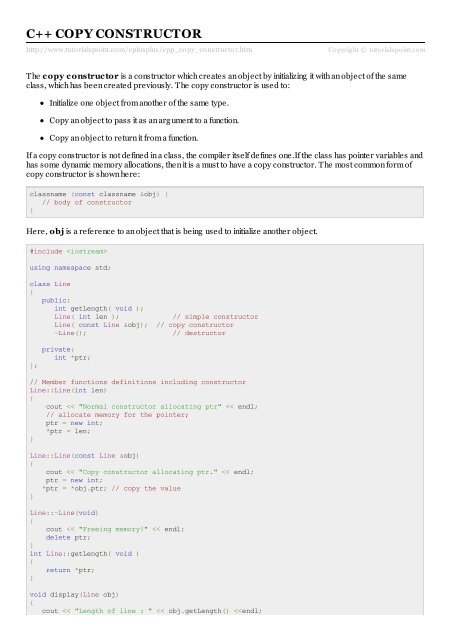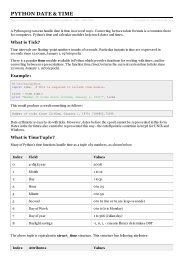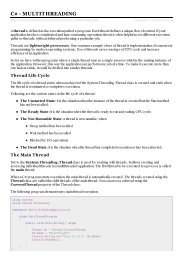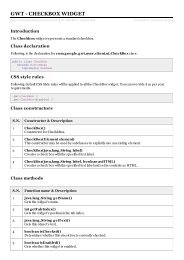C++ Copy Constructor - Tutorials Point
C++ Copy Constructor - Tutorials Point
C++ Copy Constructor - Tutorials Point
Create successful ePaper yourself
Turn your PDF publications into a flip-book with our unique Google optimized e-Paper software.
<strong>C++</strong> COPY CONSTRUCTOR<br />
http://www.tuto rialspo int.co m/cplusplus/cpp_co py_co nstructo r.htm<br />
<strong>Copy</strong>rig ht © tutorialspoint.com<br />
The copy constructor is a constructor which creates an object by initializing it with an object of the same<br />
class, which has been created previously. The copy constructor is used to:<br />
Initialize one object from another of the same type.<br />
<strong>Copy</strong> an object to pass it as an arg ument to a function.<br />
<strong>Copy</strong> an object to return it from a function.<br />
If a copy constructor is not defined in a class, the compiler itself defines one.If the class has pointer variables and<br />
has some dynamic memory allocations, then it is a must to have a copy constructor. The most common form of<br />
copy constructor is shown here:<br />
classname (const classname &obj) {<br />
// body of constructor<br />
}<br />
Here, obj is a reference to an object that is being used to initialize another object.<br />
#include <br />
using namespace std;<br />
class Line<br />
{<br />
public:<br />
int getLength( void );<br />
Line( int len );<br />
// simple constructor<br />
Line( const Line &obj); // copy constructor<br />
~Line();<br />
// destructor<br />
};<br />
private:<br />
int *ptr;<br />
// Member functions definitions including constructor<br />
Line::Line(int len)<br />
{<br />
cout
}<br />
// Main function for the program<br />
int main( )<br />
{<br />
Line line(10);<br />
display(line);<br />
}<br />
return 0;<br />
When the above code is compiled and executed, it produces the following result:<br />
Normal constructor allocating ptr<br />
<strong>Copy</strong> constructor allocating ptr.<br />
Length of line : 10<br />
Freeing memory!<br />
Freeing memory!<br />
Let us see the same example but with a small chang e to create another object using existing object of the same<br />
type:<br />
#include <br />
using namespace std;<br />
class Line<br />
{<br />
public:<br />
int getLength( void );<br />
Line( int len );<br />
// simple constructor<br />
Line( const Line &obj); // copy constructor<br />
~Line();<br />
// destructor<br />
};<br />
private:<br />
int *ptr;<br />
// Member functions definitions including constructor<br />
Line::Line(int len)<br />
{<br />
cout
Main function for the program<br />
int main( )<br />
{<br />
Line line1(10);<br />
Line line2 = line1; // This also calls copy constructor<br />
display(line1);<br />
display(line2);<br />
}<br />
return 0;<br />
When the above code is compiled and executed, it produces the following result:<br />
Normal constructor allocating ptr<br />
<strong>Copy</strong> constructor allocating ptr.<br />
<strong>Copy</strong> constructor allocating ptr.<br />
Length of line : 10<br />
Freeing memory!<br />
<strong>Copy</strong> constructor allocating ptr.<br />
Length of line : 10<br />
Freeing memory!<br />
Freeing memory!<br />
Freeing memory!

















